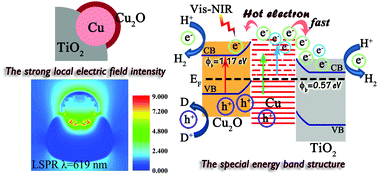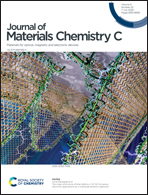Unraveling the role of cuprous oxide and boosting solar energy conversion via interface engineering in a Cu/TiO2 plasmonic photocatalyst
Abstract
The photocatalytic performance and underlying mechanism of Cu modified TiO2 have attracted a wide range of scientific interest in recent years. However, the role of copper oxidation states in the localized surface plasmonic resonance (LSPR) effects and photocatalytic activity is still debated. Here, we utilize the finite-difference time-domain (FDTD) method to mimic spontaneous oxidation of Cu (e.g., Cu2O) in Cu/TiO2 heterostructures and use density functional theory (DFT) to calculate the electronic structures of the interfaces. On the basis of FDTD results, in the case of the Cu@Cu2O/TiO2 configurations, it has been found that the LSPR peak of Cu is directly modulated to near 650 nm, and the interfacial electric field intensity is weakened. In the case of the Cu/TiO2/Cu2O configurations, in which the Cu core and TiO2 nanoparticles can directly come in contact with each other, this successfully improved the interfacial electric field intensity generated by LSPR effects of the Cu core. Moreover, Fano resonance is introduced in the Cu/TiO2/Cu2O configuration to further enhance the interfacial electric field enhancement. Meanwhile, the hot electrons generated by the LSPR effects of the Cu core readily cross the lower Schottky barrier at the Cu/TiO2 interface. Based on the analysis of electronic structures, three types of band alignments may exist in the Cu/Cu2O/TiO2 ternary composite photocatalysts, and the possible electron transfer processes are discussed in detail. Therefore, the LSPR effects (including: providing new absorption peaks in the visible-light region, enhancing the interfacial electric field, and producing hot electrons) of the Cu core can be modulated by the thickness and position of the Cu2O covering, which can be achieved by controlling the preparation conditions in practice. The existence of many kinds of interfaces in the Cu/Cu2O/TiO2 ternary composite photocatalysts makes it possible and facile to design a fast separation and transmission channel of photo-generated carriers. The coupling of interface engineering and LSPR effects provides more available strategies and degrees of freedom to promote the performance of the Cu/Cu2O/TiO2 ternary composite photocatalyst. Therefore, careful optimization is necessary to promote the synergistic boosting of photocatalytic performance of Cu/Cu2O/TiO2 ternary composites.



 Please wait while we load your content...
Please wait while we load your content...